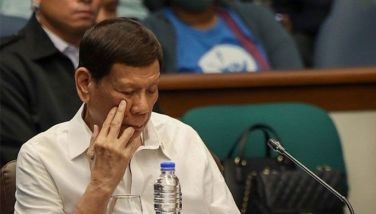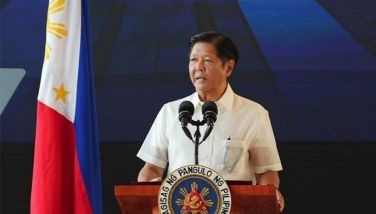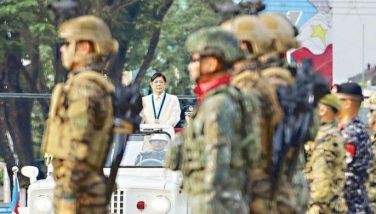Sayyaf releases Aussie hostage
ZAMBOANGA CITY, Philippines — Australian Warren Rodwell emerged early yesterday withered after being held for 15 months by Abu Sayyaf bandits in southern Mindanao.
The 54-year-old Rodwell, a former soldier, limped to freedom after he was abandoned by his escort in a coastal area in Pagadian City, Zamboanga del Sur.
He even managed to exchange jokes with some policemen and a journalist who took video footage of him at the Pagadian police station, shortly after his pre-dawn release.
“Lose weight... skeleton,†a smiling Rodwell said as he took off his T-shirt for the video camera and pointed at his ribs that were practically sticking through his skin.
He then sucked in his stomach to accentuate his weight loss.
A security official confirmed a ransom of P4 million was paid for the release of Rodwell following negotiations with the Abu Sayyaf.
There was a “misunderstanding†among the kidnappers that delayed the release, the official said.
Rodwell settled in Ipil, Zamboanga Sibugay with his Filipina wife, Miraflor Gutang, about eight months before he was abducted on Dec. 5, 2011. He had worked as a teacher in China before marrying Gutang, whom he met on the Internet.
The Abu Sayyaf originally demanded $2 million and subsequently reduced it to $1 million then settled for a lower P4-million ransom.
Authorities refused to comment on the ransom paid for Rodwell. Both the Australian and Philippine governments have strict policies of refusing to pay ransom. That left Rodwell’s family to struggle to raise funds, including selling some of their properties, according to an official confidential report.
Malacañang, however, is grateful for the release of Rodwell.
“Our primary concern was to ascertain that Mr. Rodwell would receive immediate medical attention. Presently his medical condition is being assessed and as soon as the doctors give clearance, we hope that he will be reunited with his family at the soonest possible time,†deputy presidential spokesperson Abigail Valte said.
Australian Prime Minister Julia Gillard expressed relief over Rodwell’s release and congratulated Philippine authorities for their handling of the case.
“I do want to pay tribute to the government of the Philippines and their agencies and personnel, they worked so hard to secure Mr. Rodwell’s release,†Gillard told reporters.
Dazed, confused
Police said Rodwell was spotted by a villager loitering in the port area of Barangay Sta. Lucia at 1 a.m. yesterday.
Pagadian police chief Superintendent Julius Muñez said Rodwell was immediately brought to the nearby Maritime Police station.
“He was barefoot and limping maybe due to sores. He was really thin and haggard,†Muñez said. “He looked OK, just tired. But he looked like he lost a lot of weight.â€
He said Rodwell, wearing only light brown walking shorts and a blue T-shirt, looked confused as he asked for an Australian government representative.
“Did the Australian government know already of my release?†Rodwell asked.
Rodwell said he was aware that he would be released but was not sure when it would happen. He said he was often moved and transferred by his captors while in Basilan.
“I was told to disembark from the motorboat and my escort left,†Rodwell said when he was released and left on his own.
The Abu Sayyaf had previously released a series of video clips of Rodwell as proof he was still in their custody and which showed him becoming gaunt.
In the last proof of life video, apparently taken in January, masked militants carrying M-16 automatic rifles and belts of ammunition threatened to kill Rodwell as he sat with his hands bound by rope.
“I was already expecting my release but I don’t know when,†Rodwell said inside the police headquarters while waiting to be fetched by a helicopter. He only asked for coffee and water.
The helicopter later arrived and flew Rodwell to the US Joint Special Operation Task Force-Philippines (JSOTF-P) office inside the Western Mindanao Command (Westmincom) here.
Local media were barred by the US military and Australian security service personnel and even limited the movements of the Filipino soldiers inside Westmincom.
The Westmincom, however, provided a video and several photos to journalists showing the emaciated Rodwell alighting from the helicopter wearing blue T-shirt with bullet-proof vest concealed with fatigue uniform and light brown slippers.
He was escorted by the US servicemen and whisked to a van that sped off to the American camp inside Westmincom.
Officials only said Rodwell would be moved out as soon as possible after medical treatment.
A police official, on the other hand, revealed the negotiations for Rodwell’s release took place for more than two days.
Basilan Vice Gov. Al-Rasheed Sakalahul led the negotiations following the request of Rodwell’s family and the Australian government, according to regional police operations director Superintendent Jose Bayani Gucela.
Gucela said the negotiations took place in Cabangalan, Tipo-Tipo, Basilan and the release was expected last Thursday.
“But there was misunderstanding among the Abu Sayyaf that caused the delay,†Gucela revealed.
Gucela could not elaborate what caused the misunderstanding among the kidnappers.
He could not also ascertain if Rodwell was kept in captivity by the Abu Sayyaf in Tipo-Tipo.
“They just told the negotiators to prepare because they will release Rodwell in Pagadian,†Gucela said.
During the negotiations, the Abu Sayyaf reportedly took a total of P4.5 million in ransom. They demanded the full payment up front to release their Australian captive.
While negotiations were underway in Basilan, the Westmincom received a request from the JSOTF-P for a helicopter landing inside the military camp from Basilan.
The helicopter was supposed to fly Rodwell out from Basilan and bring him to the Westmincom military hospital on Thursday evening.
“What happened out there in the jungles of Tipo-Tipo was some sort of estafa because the Abu Sayyaf bandits took the P4.5 million ransom but reneged on their earlier promise to hand over Rodwell to the vice governor,†a senior security official said.
The official added Sakalahul, after coming out of the jungles of Tipo-Tipo during the negotiations, reportedly felt the Abu Sayyaf double-crossed him.
“We don’t know really what happened next after the botched release. But we could only surmise that the anger and the frustrations of the vice governor played a key role for the Abu Sayyaf to change their minds and release their Australian captive in Pagadian,†another security official said.
Another source said the release of Rodwell in Pagadian City was designed to confuse the military against running after the Abu Sayyaf in Basilan.
“I was only informed by our assets that the rough seas prevented the early release of Rodwell. So where did they come from?†the official said.
It is also possible that all throughout his 15-month captivity, Rodwell could have been kept by his kidnappers in the Zamboanga peninsula. The group, according to the official, had direct links to the Abu Sayyaf.
“That is what the group of Wanning Abdusalam have been doing. They would make it appear that their kidnapped victims are being held in Basilan with their Abu Sayyaf contacts doing the negotiations to shake off any rescue efforts,†the official said.
Abdusalam and his men belong to a known kidnap-for-ransom gang operating in the Zamboanga peninsula.
The officials who dealt with the kidnapping said they suspected rogue members of the Moro Islamic Liberation Front (MILF), a former Muslim secessionist group that signed a preliminary peace accord with the government last year, the Abu Sayyaf and the Al Khobar criminal gang collaborated in detaining Rodwell and negotiating a ransom.
The Abu Sayyaf has a long history of kidnapping foreigners, Christians and local business people for ransom.
While the Abu Sayyaf claims to be motivated by a quest for an independent Muslim homeland in the southern Philippines, local authorities regard the group as primarily a kidnap-for-ransom gang.
It is believed to be holding other hostages, including some foreigners.
The Abu Sayyaf was set up in the early 1990s with funding from the al-Qaeda network.
About 600 US Special Forces troops have been rotating in the southern Philippines since 2002 to train Filipino troops how to quash the Abu Sayyaf.
However, the Abu Sayyaf has remained an enduring threat, partly because the militants operate with the support of local Muslim communities. – With Aurea Calica, Jaime Laude, Mike Frialde, AP
- Latest
- Trending






























